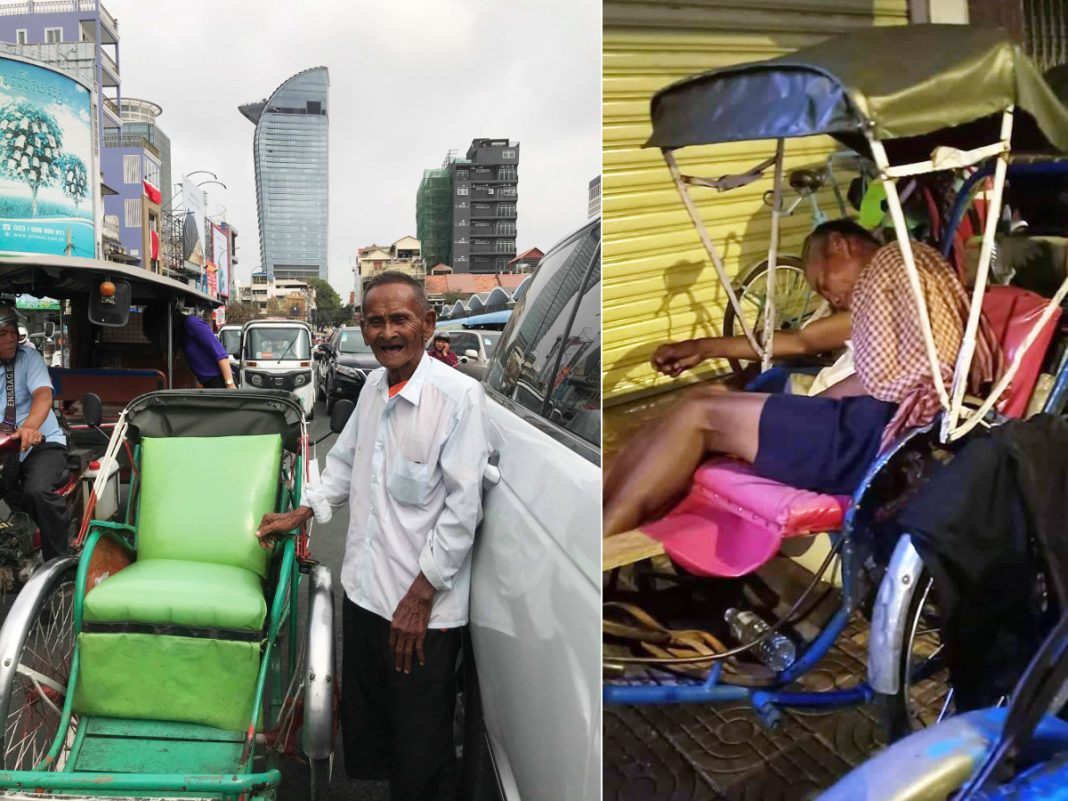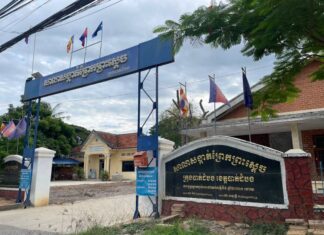Every day, before the sun shines, sweat starts to slowly stream down his forehead. His feet push hard on the pedals to make the cyclo go. His shaking hands steer cautiously to his destination.
And every night, when the moon is beaming, the coldness of the night will run through his soul. And the whole tired body will get stiff, bent over in the cyclo frame that is not built for sleeping, especially not for an old man.
This is the typical life of a cyclo driver, working painstakingly from dawn till dusk to earn every penny for a living.
At the age of 88, Ngeoun Sok is a should-be-retired cyclo driver. He has been doing this job since the collapse of the Pol Pot regime in 1979. He is still barely surviving in poverty, without proper shelter, food or clothing, in the modern city of Phnom Penh.
He can’t afford to stop, he says. His 71-year-old wife, Ma Lai, has a chronic leg disease and hasn’t been able to walk for some years. She lives in Svay Rieng province while he toils in Phnom Penh, visiting each other just a few times a year. Sok spends every night in the capital on his cyclo in front of the Angkor Hotel near Phsar Kandal market with other drivers.
“I cannot sleep well at night since there are many mosquitoes flying around. Sometimes, there is a gangster or drug user who wants to steal something from me while I sleep. so I need to be careful and stick close to other cyclo drivers,” he says.
The income from the work is meager. The rise of more modern means of transportation has left little demand for the cyclo. Motodops, tuk-tuks and taxis have long overtaken cyclos in popularity. But Sok says they are too expensive for drivers to get started with, and it’s too late for him now.
He works so his wife can go to hospital, he says. But he can’t afford good doctors and her condition hasn’t improved.
He can earn 20,000 riel ($5) on a good day; after expenses, he might have 6,000 riel ($1.5) left. He wants to send at least 100,000 riel ($25) home a month, maybe as much as 200,000 riel ($50), but it isn’t easy.
Sok Kheng, another of the city’s aging cyclo drivers, is 86. Every day begins by circling Central Market, looking for customers. When he speaks, he shows a toothless mouth.
Before becoming a cyclo driver about a decade ago, Kheng worked as a manual laborer. Originally from Kampong Speu province, he spent his days as a farmhand, or carried people’s shopping around markets for a small fee. But as he got older, he couldn’t find those jobs anymore.
As an elderly, uneducated man, he moved to Phnom Penh to become a full-time cyclo driver, work he had done from time to time in the past, he says.
He makes at most 15,000 riel a day ($3.75), he says, but even that is dwindling as fewer people see the need for the old, slow cyclo.
As he waits for customers near Central Market, around 10 a.m., he wonders if he will be able to break even that day.
“So far today, I haven’t even made 5,000 riel ($1.25),” he says. “I need to spend at least 10,000 riel ($2.5) daily.”
The loss of the cyclo’s popularity has been a long time coming. Motorized tuk-tuks, originally known as remorques, began to controversially flood the city in the early 2000s. In recent years, smaller, metal-frames tuk-tuks, tied to smartphone taxi apps like PassApp and Grab, have overtaken the older vehicles.
Nevertheless, Long Sokhouy, 41, founder of the Cambodia Cyclo Association, says cyclos continue to have a unique role as a job of last resort for elderly men without money, skills or education.
Most cyclo drivers are older, typically in their 50s to 80s, and their living conditions are poor. Age and limited resources leave no other choice for many, she says.
Cyclos provide “a small window of employment opportunities for old people in need.” It is one way of addressing poverty in society, she says.
“The general income of cyclo drivers is 10,000 to 20,000 riel ($2.5 to $5 a day), which is really low compared to other jobs. Most of the uncles are sleeping on their cyclos, using public toilets and eating what they can find near the market,” Sokhouy says.
She says using cyclos can still be a convenient option for people who need goods transported for only a small distance from markets. But most remaining demand for cyclos is from tourists.
A slump in tourists from Europe and the Americas last year — arrivals from those two regions fell 5.9 and 6.1 percent, respectively, for the first nine months of 2019 — led to an even-worse-than-usual year for cyclo drivers last year, she says, estimating the drop in demand to be as much as 50 percent.
Both the cyclo — and drivers’ livelihoods — are in danger of disappearing, she says.
Her association, established in 2013, has about 150 members, and they receive help securing bookings with travel companies, renting and repairing cyclos, and getting extra support from the government.
About two years ago, the government began providing 7,000 riel a day to cyclo drivers in an effort to alleviate their hardship.
Sokhouy says the government also talked about providing shelters for cyclo drivers, but there has yet to be any action.
“In the last few years, government officers have said they want cyclo drivers to stay in pagodas, but there has been no update,” she says.
City Hall spokesman Meth Measpheakdey did not respond to questions about the proposal.
The cyclo is everything to a cyclo driver: job, house and hope. So through their roofless lives, the drivers persevere.
“My life here is really hard,” says Sok, the 88-year-old. But the cyclo is all he has to depend on.
“It’s my rice pot,” he says. “Without the cyclo my life would be a disaster, because I don’t know what else I could do at this age. I will continue doing this until the day I cannot hit the pedals.”












